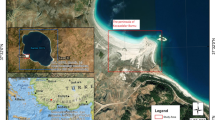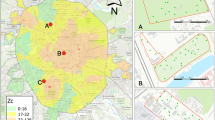Abstract
Purpose
Acid sulphate soil (ASS) has raised increasing environmental concerns because of its capability to produce strong acidity and consequent trace metal release. It is difficult to assess the occurrence and severity of ASS in the subsurface by conventional methods, either by chemical measurements following intensive field survey or by airborne/spaceborne remote sensing. This paper aims to explore a new way to rapidly assess the occurrence and severity of the harmful ASS in the subsurface.
Materials and methods
This paper introduced a proximal hyperspectral instrument, namely Hylogger™ system, which can rapidly scan soil cores and provide high-resolution hyperspectral data to assess ASS occurring in the subsurface. Traditional soil coring and chemical measurements were also applied to assist the assessment. Furthermore, partial least squares regression (PLSR) was used to establish the relationship between soil pH values and reflectance spectral features.
Results and discussion
The main results include mineral distribution, which was mapped using scanned hypespectral data on soil cores, soil pH map and the distribution of the two types of ASS, including harmful actual acid sulphate soil and harmless potential acid sulphate soil. Furthermore, the relationship between the soil pH values and spectral features was established by PLSR modelling.
Conclusions
Conclusively, ASS in the subsurface was characterised spectrally, the mineralogy was mapped using hyperspectral data from soil cores, and the AASS and the PASS were separated as well. The model established could be used to predict soil pH in the future; thus, it could further accelerate the assessment of ASS.











Similar content being viewed by others
References
Bigham JM (1994) Mineralogy of ochre deposits formed by sulphide oxidation. In: Jambor JL, Blowes DW (eds) Environmental geochemistry of sulphide mine-wastes. Short course handbook, vol. 22. Mineral. Assoc. Can. Short Course, Waterloo
Degens BP (2009) Acid sulphate soil survey of superficial geological sediments adjacent to the Peel-Harvey Estuary. Department of Environment and Conservation, Government of Western Australia. 105 pp
Farifteh J, van der Meer F, Atzberger C, Carranza EJM (2008) Quantitative analysis of salt-affected soil reflectance spectra: a comparison of two adaptive methods (PLSR and ANN). Remote Sens Environ 110:59–78
Fitzpatrick RW (2003) Overview of acid sulphate soil properties, environmental hazards, risk mapping and policy development. In: Roach I (ed) Advances in Regolith. CRC LEME Symposia, pp 122–125
Fitzpartrick RW, Merry RH, Williams J, White I, Bowman G, Taylor G (1998) Acid sulphate soil assessment: Coastal, Inland and Minespoil conditions. National land and water Resource Audit Methods Paper, 18 pp
Fitzpatrick RW, Shand P, Thomas M, Merry RH, Raven MD, Simpson SL (2008) Acid sulphate soils in subaqueous, waterlogged and drained soil environments of nine wetlands below Blanchetown (Lock 1), South Australia: properties, genesis, risks and management. CSIRO Land and Water Science Report 42/08
Gozzard JR (2007) Geology and landform of the Perth region. Western Australia Geological Survey, 126 pp
Gupta RP (2003) Remote sensing geology. ISBN 3-540-43185-3. Springer, Berlin
Haest M, Cudahy T, Laukamp C, Gregory S (2012) Quantitative Mineralogy from Infrared Spectroscopic Data II. Three-dimensional mineralogical characterization of the Rocklea Channel Iron Deposit, WA. Econ Geol 107:229–249
Hecker CA, Dilles JH, van der Meijde M, van der Meer FD (2012) Thermal infrared spectroscopy and partial least squares regression to determine mineral modes of granitoid rocks. In: Geochemistry, Geophysics, Geosystems G3, 13(2012) 15 p
Li L (2006) Partial least squares modelling to quantify lunar soil composition with hyperspectral reflectance measurement. J Geophys Res 111, E04002
Nordstrom DK, Alpers CN (1999) Geochemistry of acid mine waters. In: Plumlee GS, Logsdon MJ (eds) Reviews in Economic Geology, vol. 6A. The Environmental Geochemistry of Mineral Deposits. Part A. Processes, Methods and Health Issues, Soc. Econ. Geol., Littleton, CO. pp 133–160
Ong C, Cudahy TJ, Swayze G (2003) Predicting acid drainage related physicochemical, measurements using hyperspectral data. Paper presented at the 3rd EARSel Workshop on Imaging Spectroscopy, Herrsching,13–16 May 2003, pp. 363–373
Riaza A, Muller A (2010) Hyperspectral remote sensing monitoring of pyrite mine wastes: a record of climate variability (Pyrite Belt, Spain). Environ Earth Sci 61:575–594
Semeniuk CA, Semeniuk V (1990) The coastal landforms and peripheral wetlands of the Peel-Harvey estuarine system. Journal of the Royal Society of Western Australia 73:9–21
Sohlenius G, Öborn I (2004) Geochemistry and partitioning of trace metals in acid sulphate soils in Sweden and Finland before and after sulphide oxidation. Geoderma 122:167–175
Sommer B (2006) Drying and re-wetting of organic sediments: iogeochemistry and implication for wetland management. Thesis for the Degree of Doctor of Philosophy, Edith Cowan University
Sullivan LA, Bush RT (2004) Iron precipitate accumulations associated with waterways in drained coastal acid sulphate landscapes of eastern Australia. Mar Freshwater Res 55:727–736
Sullivan L, Bush R, Fyfe D (2002) Acid sulphate soil drain ooze: distribution, behaviour and implications for acidification and deoxygenation of waterways. In: Lin C, Melville MD, Sullivan LA (eds) Acid Sulphate Soils in Australia and China. Science Press, Beijing, pp 91–99
Sullivan L, Bush B, Burton E (2006) Acid sulphate soil development issues in the Peel Region. Report to the Department of Environment, November 2006
Swayze GA, Smith KS, Clark RN, Sutley SJ, Pearson RM, Vance JS, Hageman P, Briggs PH, Meier AL, Singleton MJ, Roth S (2000) Using imaging spectroscopy to map Acidic Mine Waste. Environ Sci Technol 34:47–54
Thomas EV, Haaland DM (1990) Comparison of multivariate calibration methods for quantitative spectral analysis. Anal Chem 62:1091–1099
Wold H (1966) Nonlinear estimation by iterative least squares procedure. In: David F (ed) Research papers in statistics. Wiley, Hoboken, NJ, pp 441–444
Wold S, Sjöström M, Eriksson L (2001) PLS-regression: a basic tool of chemometrics. Chemometr Intell Lab 58(2):109–130
Author information
Authors and Affiliations
Corresponding author
Additional information
Responsible editor: Jan Schwarzbauer
Rights and permissions
About this article
Cite this article
Shi, XZ., Aspandiar, M. & Oldmeadow, D. Using hyperspectral data and PLSR modelling to assess acid sulphate soil in subsurface. J Soils Sediments 14, 904–916 (2014). https://doi.org/10.1007/s11368-014-0847-y
Received:
Accepted:
Published:
Issue Date:
DOI: https://doi.org/10.1007/s11368-014-0847-y




